#Yin-Yang Five Elements theory
Text
Water and Soil: What is water? (4) (4/6)
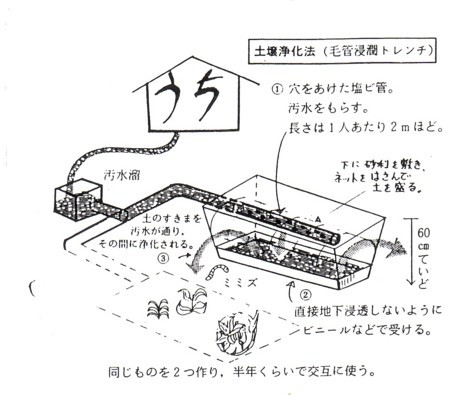
Soil Purification Method
(6 episodes in all, I will post an article I wrote in a mini comic magazine from 1984 to 1985. It is old, but I admit that it still has a certain value. My writing This is an article about training. Episode 4)
‥‥‥‥‥‥‥‥‥‥‥‥‥‥‥‥‥‥‥‥‥‥‥‥‥‥‥‥‥‥
"My elder brother is doing the food, thinking that I am doing sewerage --- the one who goes in, so this one is the one who goes out (stools)." --- My friend S talked to me. This clarity took my breath away. "Well, it's most important of everything." --- At that time, both he and I were in the "water treatment group" that researched Jun Ui's sewerage technology. In other words, I was doing monotonous experiments of boiling and baking sewage all day long.
By the way, the "sewer" is a technology that goes from the hose of the kitchen or toilet to the sea through the sewer pipe and the treatment plant. What we do at the core treatment plant is "water clearance". For example, put miso (Japanese seasoning) in water and stir it. If you leave it for a while, the upper part will become thinner and the mass of miso will sink to the bottom. The treatment plant is very similar to this. The pollutants in the water are "nutrition", and when the soil is put in and stirred, the microorganisms in the soil feed on the nutrients and grow. At this time, a large amount of air is sent in to help their breathing. Next, if left without sending air, microorganisms (called "activated sludge") will settle because they are heavier than water, so the water from the upper will be released. Activated sludge, which is a living thing, is charming because it really turns red miso when it is in good condition. However, there are quite a few things that cannot be removed because they are not big enough to eat anything.
Then, what to do with activated sludge after draining water --- what you borrowed from the soil is returned to the soil --- this is the iron rule, but that is not the case. The current sewerage system is easy to accept not only domestic wastewater but also factory wastewater, and if heavy metals and other harmful substances are mixed in the latter --- activated sludge containing a large amount of it is It is a weak point of sewerage. “Even if it is boiled or baked, it cannot be eaten.” If sludge is incinerated, the area around the chimney will be contaminated with heavy metals. We can't even return it to farmland. Mostly, they are outsourced to a contractor and landfilled or dumped in forests or oceans. (Author's note: Sludge ash containing radioactive substances generated by the Great East Japan Earthquake cannot even do that.) However, the problem is not limited to factories.
A huge pyramid is about to be built on such an uncertain foundation. Regarding "basin sewerage", which treats sewage at the level of one million people a day, there are proceedings against construction in various places, and in reality, many books can be written, but I will not mention much here. (For details, see Junko Nakanishi's "Urban Revitalization and Sewerage" (Nihon Hyoronsha). This is a good book about sewerage full of contradictions.
Actually, what I want to stick to is something more modest. I have vaguely used the word "dirt" in this series so far, but what exactly is this? To put it a little out of the ordinary, isn't it a "flush toilet"? Those that have a two-sided relationship with the benefits of "sewerage". In other words, let's do "dirty things", useless things, and foreign things far away and invisible. That's because I think it's based on the idea that the rest will be somehow. The first half of this idea is the arrogance that "I" has disappeared somewhere. The second half is irresponsible for pushing your luggage against something else. ――― In other words, the “flush toilet” is made up of arrogance and irresponsibility! ――― Is that too much to say? Will the end result be "nothing can be done"?
There is a sewerage technology called "Soil Purification Method". This is a technology that can be made one by one, which is said to be a reaction to the unnecessarily huge sewerage system. Instead of the conventional method of "treating water as water", it is intended to guide water to the basement and purify it with the powerful power of microorganisms, plants, earthworms, etc. in the soil. Since it depends on the power of the soil from the beginning, it seems that the water is actually considerably purified. However, not everything can be shed. For example, synthetic detergent. The soil dies. Also, stool. As I wrote in the first part of this series, soil is relatively incapacitated, and nitric acid, which is decomposed by proteins, causes groundwater pollution. The problem with this stool is the weakness of the soil purification method. (Although it is the whole sewerage system.) With that in mind, I think it is effective if only the wastewater is drained intermittently instead of always emission.
However, the idea of "leading water into the soil" is not perfect. Sure, there is nothing more convenient than soil to suppress odors, but isn't that exactly the "flush toilet"? In that case, I think it is more straightforward to sprinkle water, and like the old farmers, I feel familiar with the idea of using sewage as a fertilizer for the fields, keeping it close to every one. The other is that once you make a fixed device, you tend to overconfide in its ability and start to shed "dirt" as much as you want.
Now again, we have to think about what "sewerage" or "water treatment" is. Sewerage technology can only be completed by connecting water and soil. It's a good fertilizer. And I think that the blessings of that will help grow vegetables that can be eaten with peace of mind. However, does the analysis show that the "dirt" that is currently treated only as a monster can be used as fertilizer? ――― I think there is an infinite gap between “throwing away” and “keeping it alive”.
* * * * * * * * * * * * * * * * * * * * * * * * * * * * * * *
This is my current situation. One of the things I was thinking about when choosing my current apartment was that it wasn't a flush toilet. In reality, it is an apartment with a flush toilet in Koganei City on the Chuo Line. Although I can evade that there were other factors, I am firmly benefiting from the "sewerage". "Am I making something?" --- "…" At best, store the kitchen drainage without draining it, and sprinkle it later. I pee outside as much as I can.(as fertilizer). Fortunately, there is a vacant lot nearby, so I go to fill the vegetable dregs in my spare time. What a modest resistance. What's more, there is a delicious spring water nearby, and at the same time, the breathless "Nogawa(small river flowing nearby)" is flowing. What can i do?
For less than a year, I have been indebted to the neighboring greengrocer "P" in Kokubunji city. Right now, I work part-time at a store number two or three times a week, and I have a lot of fun, but I still have some concerns. It's the destination of yellow leaves and moldy tomatoes. Of course, depending on how you handle it and the understanding of the customer, you don't have to throw it away, and if I have a surplus, I can eat it, so I think this is a big difference from quarters. However, when arranging radishes in a store, I picked up the frost-damaged leaves, casually pushed them into a bag, and brought them to a garbage collection spot. I think this may be a big deal.
(Note: My teacher, Junko Nakanishi, actually called an installer to install this "soil purification method" and tried water quality analysis, and found that there was no water purification effect. )
Postscript: Human activities reduce soil
* * Water gets dirty,
Soil is gone.
Unexpectedly neglected soil (soil) is rarer than water. I made a trial calculation. In the science chronology (1993 edition), the area ratio between land and ocean is 1: 2.42. Also, the average depth of the ocean is
3795m. One-third of the land will be farmland or forest land, and the depth will be 1.5m. Then the amount (volume) of soil
1 * (1/3) * 1.5 = 0.5 (unit)
The amount (volume) of ocean water is
2.42 * 3795 = 9184 (unit)
There is an overwhelming difference.
However, since ocean water is not available, let's calculate the amount of land water, especially river and lake water. For this, we will use the landwater data of "EIC Net". http://www.eic.or.jp/ecoterm/?act=view&serial=2657
2.5% of the water on the earth is fresh water, of which 0.88% is river / lake water.
So fresh water
9184 * (2.5 / 100) = 230 (unit)
River / lake water
230 * (0.88 / 100) = 2.03 (unit), so river / lake water is soil
2.03 / (0.5) = 4.1 (times)
Although the amount of water in rivers and lakes is small compared to the total amount of water, it is about four times as much as soil. Even if the above settings change, the order (digits) will not change. Do you understand that soil is rarer than water? The soil (soil) here is a soil with a rich biota in which crops can be cultivated.
In the past log, I wrote that "pottery reduces soil",
Here, I would like to broaden my perspective and write with the theory that "human activities reduce soil." In the Ashio copper mine incident in the Meiji era, the forest died due to the sulfur dioxide gas emitted from the smelter, the soil flowed out, and the mountain became Bald Mountain. In addition, harmful metals flowed out from the slag to the downstream area, and the rice fields became barren. "Human activity is reducing the soil" wonderfully. In addition, due to the so-called global warming problem, if the sea level rises, the land will be submerged and effective farmland will become unusable. This would also be a practical example of "human activity reducing soil". Oh yeah, one thing that Southeast Asians think is very short-sighted is that they are crushing fine paddy fields and adding seawater to make them "shrimp farms" because "shrimp sell well in Japan." There is. Paddy fields that can surely produce their own food are turned into farms based on Japanese tastes and economic conditions, and they rely on cash income, so they can only be called stupid. And their activity is "reducing soil" by contaminating it with salt. Back in ancient China, how much wood was cut down and burned when making the Terracotta Warriors and Horses of “the First Emperor”(始皇帝). Rough logging leads to desertification ... China's history is certainly desertification ... a history of reducing soil.
Civil engineering and architectural engineering come first in the classification of the departments of the Faculty of Engineering (in the case of the University of Tokyo), but there are probably fewer fields that "reduce soil" as much as these two academic fields. This is also mentioned in the past logs.
Well, unfortunately, I think it is the truth that "soil is reduced" in return for "human activity".
However, as I did at the beginning of this article, "soil is rarer than water." I think that the time when "soil" disappears is the time when humans perish.
In addition, even if you are engaged in farming, you may reduce (kill) the soil. It's time to cultivate chemical fertilizers and pesticides, but when you think about it, the chemical industry intervenes. If you set up a thesis there, it seems that "human activities related to industry reduce soil". I would call this the "human extinction theorem". (By the way, there is a collection of essays by novelist Shichiro Fukasawa called "Song of the Fall of Humans" (Tokuma Shoten). I sympathize with Fukasawa's sensibility.)
* * Water gets dirty,
Soil is gone.
A word of the day: Even in the ancient Chinese thought "Yin-Yang Five Elements", soil is the most important of the five elements of wood, fire, earth, gold, and water (gogyo: the element that makes the world).
3 notes
·
View notes
Text
Energy Explained in Other Systems
There is a lack of measurable evidence because any person that has worked with energies have had different experiences but were able to understand and manipulate energies according to their own will.
Energy has been used in many ways within culture and religion and have set beliefs depending on the system being practiced.
Next, are some given definitions defining energies within diverse philosophies.
Hindu = Prana
Chinese = Qi /Chi
Japanese =Ki
Greek = Pneuma
Hawaiian = Mana
Tibetan Buddhism = Lung
Hindu Philosophy
A Sanskrit word for "life force" or "vital principle" is often referred to as Prana. It is described as first coming down from the Sun and connecting all elements of the Universe. It has been invoked within the Hindu scriptures of the Vedas and Upanishads.
Prana is the belief of vitality surrounding all living beings. This energy is responsible for all bodily functions. There are five types of pranas, collectively known as the five vāyus.
1. Prāṇa: Beating of the heart and breathing. Prana enters the body through the breath and is sent to every cell through the circulatory system.
2. Apāna: Elimination of waste products from the body through the lungs and excretory systems.
3.Uḍāna: Sound production through the vocal apparatus. It represents the conscious energy required to produce the vocal sounds corresponding to the intent.
4. Samāna: Food digestions, repair or manufacture of new cells and growth, and heat regulations throughout the body.
5. Vyāna: The energy that is needed for the body to have proper circulation, and the functions for the voluntary muscular system in which there is expansion and contraction processes throughout the body.
Chinese Philosophy
The earliest texts in which Qi or Chi is described was in 'Analects of Confucius' where it could mean "breath" and was combined with the Chinese word for blood.
Xue-qi, "blood and breath."
Living beings are born because of an accumulation of qi, and as the beings live out their lives the qi declines eventually resulting in death. This indicates that xue-qi referred to all living things, but it is believed that qi or chi exists within all things tangible.
For example, the wind is the qi or chi to the Earth, and the cosmic concepts of yin and yang are "the greatest of qi"
Yin and Yang which means "bright-dark," and "positive-negative" are the opposing forces needed in order to complement the concept of balance. There are thoughts that this duality symbolizes contradicting energy forces which manifest as light and dark, fire and water, expansion, and contraction. With this said, Chinese medicine states that the balance of negative and positive forms in the body are believed to be essential for overall satisfactory health.
Japanese Mythology
During the sixth and seventh centuries the Chinese word qi (or chi) was written using the same kanji script for their interpretation for energy being "Ki"
However, the meanings are a tad different.
While the Chinese use chi or qi to describe that energy exists in all things, animate and inanimate objects, the Japanese believe it is the creative flow and expressions used within our daily lives, martial arts, and symbolizes aspects of nature, and thusly the spirits. It is the transfer from living, animate beings in to inanimate which can change and manifest into various forms. It is the necessary intentions one wields.
Greek Mythology
Pneuma, "The breath of life" or "vital spirit" is composed of kinetic energies within the vessel, while Ignis is composed of thermal energies. All human beings need both kinetic and thermal energies in order to properly function.
In Greek medicine, pneuma is the form of circulation throughout the body's vital organs. Due to this the role, pneuma plays within the body to sustain consciousness. Some physiological theories suggest that the pneuma mediates between the heart, and the heart is regarded as the seat of the mind, and the brain.
In similar, Stoic philosophy, pneuma is the active and generative principles that are organized between the individual and the cosmos. The highest forms are the Gods, and the human soul. The human soul is believed to be fragments of the gods given life force in order to be born and given a vessel upon the physical plane. This exists within all animate and inanimate objects as energy transfers and changes.
Hawaiian Mythology
Mana, the spiritual energy of power and strength. This energy exists within places and people; however, it is said that mana is both external and internal concepts.
The Hawaiian people believe that individuals can gain mana or lose it depending on one's actions in everything that they do.
In mythology there were two ways to gain mana, and this was either done sexually or through violence.
To sexually gain mana one must invoke the god, Lono, deity of peace and fertility.
To gain mana through violence one must invoke the god Ku, deity of war and politics.
Tibetan Buddhism
Lung means the wind or breath. Exists as a key concept in Vajrayana traditions. Generally, it's concept relates to the understanding of the subtle body, and Three Vajras. Those three are the body, speech, and mind. Lung relates to the subtle flow of energy and the five elements. (Fire, Water, Earth, Space, and Air) Lung is mostly closely connected to the Air Element.
Lung has also been used to describe the winds or prana being used in conjunction with the subtle body during a time of exercise, but also more importantly everyday functions of the body and its own senses. There are five psychic winds which manifest into mahabhuta. These five relate to the lifeforce that animate the body-mind (namarupa) of all sentient beings.
The Five Root or Major Winds
The root winds support an element and is responsible for a function of the human body.
The 'life-supporting wind' (Tib. སྲོག་འཛིན་རླུང་, sok dzin lung; Wyl. srog 'dzin rlung).
Located in the brain, this lung regulates functions such as swallowing, inhalation, and concentration.
The 'upward-moving wind' (Tib. གྱེན་རྒྱུ་རླུང་, gyengyu lung; Wyl. gyen rgyu rlung).
Located in the chest and thorax, this lung regulates, among other things, speech, the body's energy and vitality, memory, mental endeavour and diligence.
The 'all-pervading wind' (Tib. ཁྱབ་བྱེད་རླུང་, khyap ché lung; Wyl. khyab byed rlung). Residing in the heart, this lung controls all the motor activities of the body.
The 'fire-accompanying wind' (Tib. མེ་མཉམ་གནས་རླུང་, me nyam né lung; Wyl. me mnyam gnas rlung). Found in the stomach and abdomen area, the fire-accompanying wind regulates digestion and metabolism.
The 'downward-clearing wind' (Tib. ཐུར་སེལ་རླུང་, thursel lung; Wyl. thur sel rlung). Located in the rectum, bowels and perineal region, this lung's function is to expel faeces, urine, semen, and menstrual blood. It also regulates uterine contractions during labour.
The Five Branch Winds
The five branch winds enable the senses to operate.
The naga wind (Tib.ཀླུའི་རླུང་, lu'i lung; Wyl. klu'i rlung). This lung connects with the eyes and sight.
The tortoise wind (Tib. རུ་སྦལ་གྱི་་རླུང་, rubal gyi lung; Wyl. ru sbal gyi rlung). This wind connects with the heart and the sense of hearing.
The lizard wind (Tib.རྩངས་པའི་རླུང་, tsangpé lung; Wyl. rtsangs pa'i rlung) associated with the nose and the sense of smell.
The devadatta wind (Tib.ལྷས་བྱིན་གྱི་རླུང་, lhéjin gyi lung; Wyl. lhas byin gyi rlung) related to the sense of taste.
The 'king of wealth deities' wind (Tib. ནོར་ལྷ་རྒྱལ་གྱི་རླུང་, nor lha gyal gyi lung; Wyl. nor lha rgyal gyi rlung). This wind connects with the body and the sense of touch.
#energy work#pagan#witch#witch community#pagan witch#witchblr#witchcraft#beginner witch#baby witch#witch tips#energy manipulation#philosophy#theology#greek mythology#hindu mythology#buddhism#hawaii mythology#chinese mythology#japanese mythology#metaphyics#metaphysical#spiritualism#spirituality
341 notes
·
View notes
Text
I FINALLY got to watch the latest season of Dragons Rising and I have a theory about who Ras’ master is, so for anyone who hasn’t caught up on Ninjago please keep scrolling because this is gonna have a lot of spoilers:
I believe there is a chance that Ras’ master may be the First Dragon, due to the similarities between his and Lloyd’s visions among other reasons.
To get this out of the way, I am not referring to Firstbourne. I am aware she is technically the “mother of all dragons”, but I believe her namesake gives it away that she may not be the very FIRST dragon. She is the first dragon BORN, perhaps not the first in existence.
Besides, do you really think the most powerful dragon in all of the worlds, the one supposed to be as powerful as the Overlord, would be defeated so easily by a small group of Oni, with other dragons AND riders on her side?
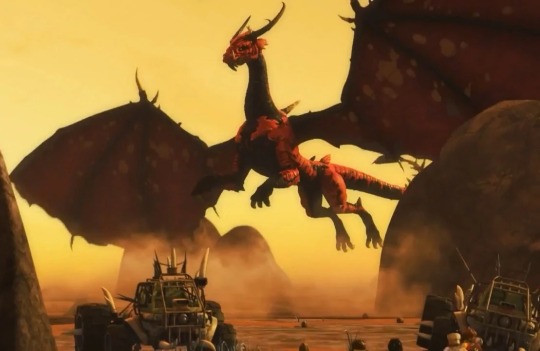
I mean THE Dragon, the one depicted in Mistake’s story. The antithesis of the Overlord. The Yang to his Yin. The Creation to his Destruction.
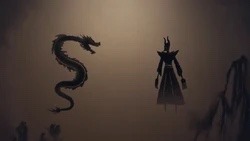
This sounds a bit far fetched, I am aware, but I do have a base for this theory.
In Mistake’s story, the Dragon was also fighting over the First Spinjitsu Master, just like the Overlord was. What is interesting to me is that the FSM chose to run from both instead of choosing the Dragon, despite the dragons always being depicted as “the good guys” and the Oni as “the bad guys.”

This means that the dragon most likely didn’t want to use him for the right reasons either, maybe even to eliminate the Overlord and overturn the balance of the world in its favor. The FSM is the balance, and he most likely knew that siding with one or the other would be disastrous.
The Dragon also has not been seen for the entirety of the series, despite the fact that the Overlord had been rampaging in Ninjago over and over. It isn’t like they could not come to stop him, we knew from the very beginning that dragons can traverse realms (I know this is probably because the dragon hadn’t been introduced in the plot yet, let me dream). Perhaps the Dragon had been sealed away by the FSM, not unlike the Overlord was when the FSM split Ninjago in two to keep him at bay.

It would explain the Dragons absence throughout the years.
Now, onto Ras.
He receives visions in a very similar way to Lloyd, almost to a T with the floating and glowing eyes, but with a GOLDEN background, which not even the Sources have, despite their connection to creation.
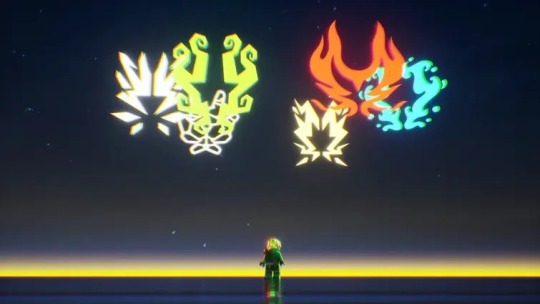
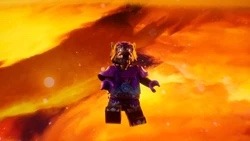
As for the “evil” masks, remember that the Forbidden Five that his master wanted to bring back are ELEMENTAL MASTERS, people who have been commonly paired with the dragons throughout history, as seen by the ninja themselves. Despite the corruption of their powers, it isn’t Destruction: it is simply warped Spinjitsu, corrupted Creation.
Perhaps the dragon needs the Sources to regain its strength, or hell, its powers were divided to CREATED the Source dragons, each one acting as a seal to keep it at bay. This is may be why they want to conquer the Sources, to free the First Dragon.
Another detail I have noticed, this might be a bit of a stretch but tigers and dragons tend to be a motif I have seen in mythology a lot, it would make sense for it to occur at least once in the show.
To wrap it all up, Creation can be used for evil and Destruction can be used for good. They are not black and white, but shades of grey. We have seen this in the show itself, for example, Gardamon in s2 with the Megaweapon for evil, a weapon that can only create:
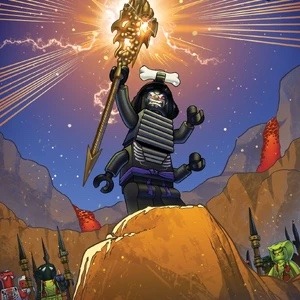
And in s16 when Lloyd used his destruction to fight the Overlord for good (and in the original ending before it was changed, kill him):
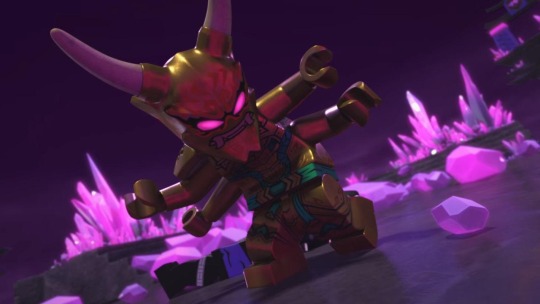
Creation and Destruction have no morality, and no one shows this better than the FSM himself:
The First Spinjitsu Master chose neither Oni nor Dragon for a reason. Light can be just as blinding as the Dark.
#ninjago dragons rising#ninjago crystalized#ninjago dragon#ninjago#ninjago lloyd#ninjago ras#ninjago garmadon#ninjago overlord#ninjago theory
24 notes
·
View notes
Text

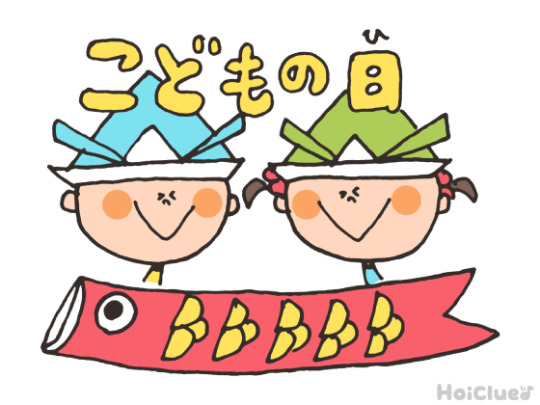


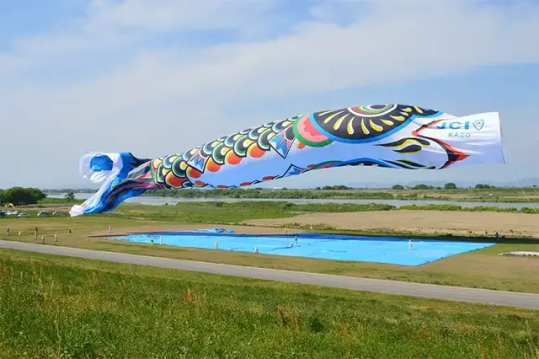
Sean bienvenidos japonsistasarqueológicos, a una nueva entrega cultural en esta ocasión os voy comentar la festividad, del día del niño que se celebra cada 5 de Mayo que se llama Kodomo no Hi y se escribiríaこどもの日 una vez dicho esto pónganse cómodos que empezamos.
-
¿Cuándo surgió el día del niño?La festividad, surge en el siglo VIII d.c en lo que respondería al periodo Heian, posiblemente tendría influencia de china al respecto ya que se basó en Tango no Sekku. El Sekku se basa en los puntos de inflexión de las estaciones y se basa en la teoría de los cinco elementos del yin y el yang en China.
-
La forma tradicional de celebrarlo es ofrecer ofrendas estacionales a los dioses, rezar y comer juntos los productos de segunda mano.En el período Kamakura, en pleno auge de los samurais, se convirtió en un evento importante para orar por el crecimiento y la salud de los niños y la prosperidad de la familia, con adornos como armaduras, cascos, serpentinas de carpa y muñecos festivos.
-
Ahora a continuación mencionaré algunos dulces de los que se suelen comer el 5 de Mayo: Kashiwa mochi,Chimaki, beko mochi, akumaki , pastel no koi.
-
Espero que os haya gustado y nos vemos en próximas publicaciones y que pasen un feliz día del niño.
-
今回は、毎年5月5日に行われる「こどもの日」というお祭りについてお話しします。「こどもの日」とは、「こどもの日」と書いて「こどもの日」と読みます。
-
こどもの日」の起源は、紀元8世紀の平安時代にさかのぼりますが、「端午の節句」が元になっていることから、中国の影響を受けている可能性があります。節句とは、季節の変わり目を表すもので、中国の陰陽五行説に基づくものです。
-
季節のお供え物を神に捧げ、祈り、中古品をみんなで食べるのが伝統的な祝い方です。 武士ブーム真っ只中の鎌倉時代には、甲冑や兜、こいのぼり、祝い人形などを飾り、子供の成長や健康、家族の繁栄を祈る大切な行事となりました。
-
柏餅、ちまき、べこ餅、あくまき、こいのぼりのお菓子です。
-
気に入っていただけたなら幸いです。今後の記事でお会いしましょう。そして、楽しい子供の日をお過ごしください。
-
Welcome to a new cultural delivery in this occasion I am going to comment on the festivity, the day of the child that is celebrated every 5th of May that is called Kodomo no Hi and it would be writtenこどもの日 once said this make yourselves comfortable that we begin.
-
When did Children's Day come about? The holiday, which dates back to the 8th century AD in what would be the Heian period, was possibly influenced by Chinese in this respect as it was based on Tango no Sekku. Sekku is based on the turning points of the seasons and is based on the five element theory of yin and yang in China.
-
The traditional way to celebrate it is to offer seasonal offerings to the gods, pray and eat second-hand goods together. In the Kamakura period, at the height of the samurai boom, it became an important event to pray for the growth and health of children and the prosperity of the family, with decorations such as armour, helmets, carp streamers and festive dolls.
-
Now here are some of the sweets usually eaten on May 5th: Kashiwa mochi, Chimaki, beko mochi, akumaki, no koi cake.
-
I hope you liked it and see you in future posts and have a happy children's day.
#日本#こどもの日#平安時代#中国#端午の節句#鎌倉時代#佐村河内#柏餅#ちまき#歴史#あくまき#ケーキ#こい#japan#KodomonoHi#Heianperiod#china#Tangonosekku#Kamakuraperiod#samura#Kashiwamochi#Chimaki#history#akumaki#cake#koi#culture#文化
9 notes
·
View notes
Note
Hi there! I remember in one of your previous analyses that you'd love an opportunity to talk about shikigami (I think). As someone who is also quite curious about it, would you mind divulging on the subject?
Oh of course, thanks for reminding me!
Shikigami: From History to Len'en
Shikigami, like barriers (which I also did a Len'en-focused analysis on), is one of those things I feel like many who are into Japanese media, especially traditional fantasies, have a general idea about, yet don't really have a grasp on their real-life conception and history.
So, just like in the barriers post, let's take a look at what shikigami are all about, in real-life history and in the Len'en series!
Origins of Onmyōdō
To understand the origins of shikigami, we first have to have a cursory understanding of the complex art of Onmyōdō (陰陽道 lit. "the way of Yin and Yang").
Roots in Chinese Philosophy
Onmyōdō, as we understand it, has its roots in the Chinese philosophical Theory of Yin-Yang and the Five Phases (陰陽五行思想).
Yin and Yang (陰陽) can be described as the fundamentally opposite but interconnected forces that constitute as well as cause change in everything in the universe.
The Five Phases (五行) is a conceptual framework which is used to classify and explain a wide array of phenomena, including the movement of celestial bodies, the interaction between internal organs to, the rise and fall of political regimes and the properties of medicine, amongst other things. The five phases are, in order, fire, water, wood, metal, earth.
The Theory of Yin-Yang and the Five Phases then combines the two, and was associated with and used for a variety of (what were at the time considered) natural sciences, such as astronomy, calendar making, time keeping and divination.
Development in Japan
When transmitted to Japan alongside Confucianism, Daoism, Buddhism, it was accepted by the Japanese people as having actual power, and its associated practices like divination and manipulating fortune were accepted as well.
As these beliefs and practices fused with the native Japanese beliefs (what one may classify as Shinto) and Japanese Buddhism (remember that Buddhism also had its own major developments in Japan), a system of beliefs and practices that were uniquely Japanese was born.
This was Onmyōdō, and it was a state-controlled craft. Onmyōji (陰陽師 lit. "master of yin and yang") were the practitioners of this craft who belonged to the Bureau of Onmyō (陰陽寮), and they offered their services to the royal family and the noble elites.
The Historical Shikigami
Examining the Word "Shikigami"
Now that we can finally take a look at the historical shikigami. They are known by a number of names: shikigami/shikijin (式神・識神), shiki-no-kami (式の神・識の神), shi-ki (式鬼) or shiki-kishin (式鬼神).
No matter the rendering, there is a common element throughout most of them: 式 read shiki or just as shi. It means "to make use of", and refers to the onmyōji's control over these beings.
The specific beings that these names list are kami (神 gods/spirits), oni (鬼) and kishin (鬼神). The last term refers to a myriad of concepts, from wild and rampaging kami to divine spirits to any supernatural thing that causes mysterious phenomena.
Below: Famous onmyōji Abe no Seimei (in black) accompanied by two of his shikigami (below Seimei).
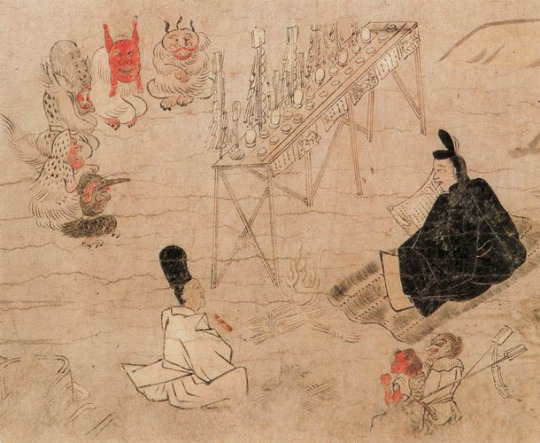
So, from the name, we can tell that shikigami refers to the gods, spirits, supernatural beings and even just supernatural forces under the onmyōji's control. Additionally, it is said that the process through which an onmyōji summons these spirits is also called shikigami..
Types of Shikigami
Shikigami are in fact invisible to everyone except their master, but can take on forms that are visible to the average person. In general, shikigami can be classified in to two ways:
One is according to the form they appear in, such as human-shaped (人型), bird/beast-shaped (鳥獣型), youkai-shaped (妖怪型), etc.
More interesting, perhaps, is classifying them based on how they were created:
First are "mental-action shikigami", (思業式神 shigou-shikigami) they are manifested through the onmyōji's thought, and are said to directly reflect their master's ability.
Next are "personified shikigami" (擬人式神 gijin-shikigami), they are produced by imbuing a doll, often made of paper, straw or plants, with spiritual power. Those which obtain a will of their own are considered higher-rank, while those that do not are considered lower-ranked.
Below: A straw doll used to summon a shikigami into.

Final final type are called, literally, "gods of evil deeds and revealed retribution" (悪行罰示神 akubyoubasshi-kami). It's rather unwieldy and not exactly clear what it means.
So instead, I'll call these "shikigami through karmic retribution". They are typically beings who committed evil deeds in the past who are defeated and subjugated by onmyōji, becoming their shikigami.
The final type, perhaps obviously, are considered particularly dangerous, as an unskilled master can be overpowered by the shikigami, allowing it to cause harm to its master and others.
Functions of a Shikigami
Basically, there's nothing a shikigami cannot do, as they are (provided that the onmyōji is powerful enough) completely bound to the will of their master.
Here I'll just briefly list a few of what shikigami were said to be used for throughout history and myths:
Defeating harmful and devil spirits
Possessing someone to cause them harm
Placed at key locations as protector deities
Pass on messages and deliver objects
Reconnaissance
Housework, house-watching and personal care
Yeah, basically anything you can think of.
Onmyōdō in the Present Day
Persistance and Development
Onmyōdō and onmyōji, along with the Bureau of Onmyō, persisted throughout Japanese history, slowly gaining popularity amongst the general populace as well. It has its ups and down, even losing its official status once, but it never faded away.
One particularly famous Onmyōji that should not go unmentioned is Abe no Seimei (安倍晴明), said to be a genius in the art. Many of his exploits are left behind as legends, and he himself is a popular topic of many modern fiction stories.
Below: Mitori's Pentagram "Bellflower Seal Crush", based on a seal of the same name invented by Seimei to ward off demons.

Fall and Modern Status
It was not until the after Meiji Revolution, in 1870, that the new government passed a bill to ban Onmyōdō as a superstition, under the support of pure Shintoists and the exclusionists, who rejected Onmyōdō based on its Chinese roots.
After this, the Onmyōdō of old basically disappeared from Japanese society. Later, when the ban was lifted, Onmyōdō was already reduced to a point where it would never return to the level of prestige and power it once held during the Heian period.
Nowadays, there are two schools of Onmyōdō left, the "Tensha Tsuchimikado Shinto" (天社土御門神道) and the Izanagi School (いざなぎ流).
Tensha Tsuchimikado Shinto
This school was established by a family that traces it lineage back to Abe no Seimei, the Tsuchimikado Family.
Thanks to its fusion of Onmyōdō and Shinto, it was able to survive the ban on Onmyōdō by leaning on its Shinto side. Though it would lose official support regardless and turn to private practice.
The Izanagi School
A unique folk religion developed independently in the archaic Tosa Province (modern day Kōchi Prefecture). It has elements of Onmyōdō belief and practice, but aren't recognised by Tensha Tsuchimikado Shinto.
Popular Culture
The colourful stories of onmyōji from various legends, especially of them binding youkai to their control and excercising other mystical powers, captured the popular imagination and lead to a myriad of fictional depictions of them.
It is here that the most common depiction of shikigami emerges, as youaki bound by onmyōji, or spirits summoned into paper dolls by them. And it is here that we loop back to Len'en.
Shikigami of Len'en
The most info on shikigami in the Len'en series can be found in Garaiya Ogata's BPoHC profile:
A shikigami receives spiritual power from its master, and can act using the accumulated spiritual power from them.
How much spiritual power they can save up and what they can do with said accumulated power varies from shikigami to shikigami.
[...]
However, the master's spiritual power is naturally limited.
[...]
However, since a slight amount of their master's power is constantly consumed to keep their shiki up and running. Multiplying too much will overburden their master, ultimately deactivating the shiki.
It would seem that shikigami run on a fairly unique set of rules in Len'en, that of an exchange and balance of spiritual power between master and subject.
The master needs to use their power to somehow activate and maintain a shiki contract with the subject, which creates a link between the two and allows the subject to draw on their masters power. In the case that the master runs out of power, the contract immediately deactivates.
The amount of spiritual power a shikigami stores seems to be somewhat proportional to how powerful they are, as seen in Kuriju Kesa being technically weaker than Kaisen Azuma, but still seen as more useful thanks to the former being better at storing spiritual power from Garaiya.
We don't really know much else about shikigami in the series, though there are a few things that we can speculate upon.
Bound Evildoer Shikigami
First we can examine the most prominent master-shikigami pairs, that between Garaiya and Kaisen & Garaiya and Kurjiu.
Below: Garaiya with Kaisen and Kujiru in animal form.

It's possible that these two are what I called "shikigami through karmic retribution", as they were apparently "pretty mischievous" in the past, prior to meeting Garaiya.
This is particularly likely with Kaisen, as one of their inspirations, the Chinese mythological creature known as Jinchan (金蟾 Lit. "gold/golden toad"), actually has pretty much this play out, just framed under Daoism instead of Onmyōdō.
In the folktale Liu Hai Tricks Jinchan (劉海戲金蟾), it is said Liu tamed a malevolent and greedy three-legged toad after fishing it out of the east sea. It became Jinchan and was henceforth the immortal's companion, following Liu wherever he went.
So yeah, basically "evil youkai does bad deeds" → "good person comes around and tames it" → "evil creature now serves the good person somehow".
With Kujiru, it's not as direct, since their basis, Kesa-gozen (袈裟御前), was the victim in her story, rather than the villain or a villain redeemed. Still, if JynX wanted to somehow collapse both the villain and the victim into one, they certainly can, so I can't really say that this disproves Kujiru as a "shikigami through karmic retribution".
Bonus Note: Jinbei
There's really not enough information on Jinbei to say much about them as a shikigami, but it's interesting to note that they don't (or at least don't only) draw power from their master.
Rather, they draw power from and supply power to the Mugenri Barrier, the current Senri priests (Yabusame and Tsubakura) as well as a yet undisclosed source.
On a personal note, Jinbei gives me the vibe of a spirit that was summoned into an object. Similar to the personified shikigami, though not summoned into a doll, but into the very jinbei that they're always wearing.
Conclusion
There's still much that we don't know about shikigami in Len'en, so other possibilities still exist with both Kaisen, Kujiru and Jinbei.
For example, Kaisen and Kujiru can also be spirits summoned into the youkai, akin to how the Touhou series conceptualises its shikigami. Or Jinbei could be a youkai who's subjugation contract is renewed with every new Senri priest.
Basically what I'm saying is that canonically all we have is the Garaiya profile and the two related 2021 interview answers that I've linked.
In any case though, I hope you at least got something out of the first part about the historical shikigami, and how they are classified and used even to this very day.
As usual, I hope you enjoyed~! :)
#len'en#len'en project#len'en lore#garaiya ogata#kujiru kesa#kaisen azuma#jinbei#jinbei len'en#shikigami#I tried to find english translations for these terms#but like I said#well known in popular culture but not in its historical understanding#so it was difficult to find much about this in english#I'm leaving the “jinbei” tag there#maybe this'll be interesting for the traditional Japanese fashion crowd#who knows?
21 notes
·
View notes
Text
Worldbuilding and Theories of Engage
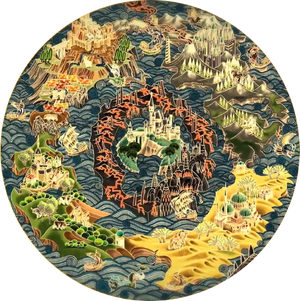
Lythos and The universe.
If you look at the map of Elyso you can see that the kingdoms of Firene, Brodia, Elusia and Solm form a circle around Lythos and Gradlon. The four kingdoms each represent a season.
Firene - spring
Brodia - autumn
Elusia - winter
Solm - summer
Each kingdom also represents one of the five 'godia' or elements in Buddhist traditions.
Firene - spring - air - represents growth, open-mindedness, wisdom and freedom
Brodia - autumn - earth - represents foundation, being acted upon, stability and stubbornness.
Elusia - water - represents flow, change, emotion and adaptability.
Solm - fire - represents creativity, motivation, passion, intensity and desire.
Gradlon/Lythos - the void - represents the source of the human spirit, everything, nothing, absence and death.
Lythos and Gradlon form a solar eclipse in the centre of the universe. A solar eclipse happens when the Moon covers the Sun's center, leaving the Sun's visible outer edges to form a “ring of fire” or annulus around the Moon. Lythos is a crescent shape and is the moon in the solar eclipse. Gradlon is the sun forming a 'ring of fire' around Lythos. In Tibetan Buddhism it is believed that during a solar and lunar eclipse that one's good and bad deeds are multiplied by 10,000. The good deeds of The Divine Dragon and the bad deeds of Sombron are multiplied.
A solar eclipse always coincides with the new moon. It is a sign of change and new beginnings. Gradlon rising to form the eclipse signifies new beginnings for Alear and Veyle. Veyle had a new beginning as her true self, a Dragon that helps people and saves the world. Alear has a new beginning as an Emblem. A new family is formed between Alear and Veyle. Each leader has a new beginning in a world of peace and mutual understanding with greater communication between the kingdoms.
It is important to note that despite Lythos being the shape of a moon, the country's symbol is the sun. It is the same situation with Gradlon, the country is the shape of the sun and their symbol is the moon. This represents yin-yang. Ying and yang are not in conflict, they compliment each other to create balance. The fell and divine in Alear create a perfect balance. Alear and Veyle working together create balance. Yin-yang represents the uniting of opposites to create balance.
Gradlon and Lythos also represent as above, so below. There is harmony, agreement and correspondence between each plane. What happens in life is reflected in death, what happens in heaven is reflected in earth. The ideal Elyso is one where yin-yang is in perfect harmony and where as above, so below is in agreement. The Xenologue demonstrates what happens without the Divine Dragon and humanity working together in perfect harmony, heaven falls (the Somniel has literally fallen from the sky,) and humanity falls to ruin (all the leaders are dead and the corrupted act like the living). Without the complimentary divine to work with the fell the world cannot be saved. It is only when the Divine Dragon is summoned to the fallen Elyso are they then able to save those who are left.
Lythos and Gradlon as shadow and light.
Within you is light and shadow, both need to be recognized to understand who you really are.
The shadow is the part of you that you do not want to see, not others to witness. Gradlon as the shadow at the start of the game is hidden under water, hidden from view. The shadow is feared, hated, in denial and projected elsewhere. Sombron's inability to connect with others is projected onto the bonds of others, because his connections are weak and easy to break, which means that everyone else is the same. He loathes his enemies inability to admit failure, weakness and defeat because he cannot admit the same.
The shadow is not evil but without facing it and recognizing it as evil you allow yourself to do evil deeds without recognising it as evil. Sombron believes he is justified in his actions because of his experience of isolation. People are not people, they are props to be used. His children are manufactured goods made to serve his ego. No one matters except his ego.
"Take the plank out of your own eye, and then you will see clearly enough to take the splinter out of your brother's eye" (Matthew 7:4-5)
Sombron is never able to face the shadow side of himself. Veyle and Alear are able to.
Veyle sees the shadow side of herself, she does not identify with the cloaked figure who delights in harming people, however she understands that it only represents part of who she is. Completely identifying as cloaked Veyle would lead to much evil. She brings light to the shadow part of herself by believing in Alear, believing she can make connections and help people and by learning that Sombron is only a shadow of a father figure who wants to use her for his own ends. If the cloaked figure won she would have lived and been driven by fear and malice. Veyle pours light into the shadow side of herself by breaking the helmet from her head. When she first learns of her shadow side she confronts it with anger, surprise and fear. When she stands up for herself and faces her shadow with determination and sadness she sees how broken and needy her shadow self was. Veyle knows she has sinned and is saddened by what she has done and seeks redemption. The final desperate plea for a father that never loved her by her shadow self represents that broken and needy self. Most importantly to move on from her shadow she needs to forgive that part of her. She forgives Zephia and says she will remember her and she says goodbye to her father and holds no malice towards him. With her dark side recognised and faced up to, she is ready to open her heart up to the light of the Divine Dragon Alear. She still has a little way to go to accept her fell dragon side.
Alear faced up to their dark side when they discovered the truth of their identity. At first they were shocked and humiliated, their ego took a knock. The ego does not like the truth about the shadow self being revealed. Alear believed they could not be a good dragon if they were a fell dragon. By recognising and facing the fell part of themselves they are able to embrace the light and transcend to an emblem.
Alear's shadow self projects their feeling of impurity upon the corrupted, that is why they fear them, they see the unholy fell energy within them that is within themselves. Alear faces their shadow self by becoming one of the corrupted and continuing to fight for peace. The shadow self is also demonstrated when Alear loses Marth. Alear can only embrace the light when they start to believe in themself and their self worth. Throughout the game Alear grows into the role of divinity, they are able to project confidence and give hope to their allies. They believe in their power to summon emblems even after Sombron has drained them of power. Defeating Dungeon is a symbol for defeating the shadow self. Importantly Alear does not show malice, instead they try to summon emblem X in hope that Sombron could, one day, find the light.
#fe engage#fire emblem engage#the holy land of lythos#the land of lythos#lythos#the somniel#Gradlon#firene#brodia#Solm#elusia#fe sombron#fe alear#fe veyle#Veyle and Alear
15 notes
·
View notes
Text
How am i going to organize my Miraculous' remakes: Part 2/2 - Reworking on the Miraculouses' powers
When I was looking for reworks of Miraculous powers for inspiration, I stumbled upon this post. Literally spent the whole night processing the amount of information the text contained
So when I finally understood everything and organized my thoughts, I started writing, taking all the references in the post into account, but adapting everything to my personal tastes and current powers after all of them were finally revealed (OP's post is from 2019) since I don't want to leave a drastic change, because analyzing well, the canon powers match perfectly with each holder.
According to OP, following the Yin Yang, Wu Xing and Sheng Xiao symbolisms more accurately, the division of powers should look like this:
Ladybug and Cat Miraculouses - Five powers
Fox, Bee, Turtle, Peacock and Butterfly Miraculouses - Two powers
Mouse, Ox, Tiger, Rabbit, Dragon, Snake, Horse, Goat, Monkey, Rooster, Dog and Pig Miraculouses - Only one power

"Why?" You may ask. And here is the answer. The Ladybug and Cat Miraculouses are the most powerful Miraculouses of the most powerful Miracle Box; They represent the Yin and Yang, concepts of Taoism that expose the duality of everything that exists in the universe and describe the two opposing and complementary fundamental forces. It really made sense to me that they should've had more than one power.
Thing is, they already have. Ladybug explicitly has 2 powers (3 if you consider capturing akumas and amoks as a particular power) which are Lucky Charm and the Miraculous Ladybug's cure. The issue with Chat Noir and Cataclysm is something I will address further down.
Back to the explanation, now I need to talk about the Wu Xing so that things make sense later.

The 5 phases theory, which is a more correct translation, states that wood (木), fire (火), earth (土), metal (金) and water (水) are the basic elements that form the material world.
There would be an interaction and reciprocal control between them that would determine their state of constant movement and change. They also represent the passage of time, seasons, cardinal directions, organs of the human body, cosmic periods and are even linked with properties of medicine.
There are four cycles: the generating one, the weakening, insulting and controlling. This concept would be something cool to play with, with all the possibilities of combinations, but I admit that it would be something more complex than it already is.

Apparently, Thomas took inspiration not from the colors of each element, but from what they represent. Still following OP's logic, each power and animal chosen would be derived from what the element affects and express. Therefore, the pattern would be:
Wood -> Mind -> Fox (Illusion)
Fire -> Energy -> Bee (Subjection)
Earth -> Body -> Turtle (Protection)
Metal -> Soul -> Peacock (Emotion)
Water -> Heart -> Butterfly (Transmission)
And each element would have its Yin and Yang ability, as it encompasses the Wu Xing. Every Yin ability would be more defensive/supportive/passive/collective, while every Yang ability would be more offensive/agressive/active/individual, so i came to this conclusion:
Fox
• Wood/Mind (Yin): Defense - Mirage
• Wood/Mind (Yang): Offense - ?
Bee
• Fire/Energy (Yin): Defense - ?
• Fire/Energy (Yang): Offense - Venom
Turtle
• Earth/Body (Yin): Defense - Shell-ter
• Earth/Body (Yang): Offense - ?
Peacock
• Metal/Soul (Yin): Defense - Amokization
• Metal/Soul (Yang): Offense - ?
Butterfly
• Water/Heart (Yin): Defense - Akumatization
• Water/Heart (Yang): Offense - ?
Now that I've determined the mind, energy, body, mind and heart thing, we can go back to the Ladybug and Cat Miraculouses.
As I said, the Yin Yang encompasses the Wu Xing, so Ladybug and Chat Noir's powers most likely would work that way:
Ladybug (Yang)
• Positive Mind: Inspiration - ?
• Positive Energy: Creation - Lucky Charm
• Positive Body: Strength - ?
• Positive Soul: Life - ?
• Positive Heart: Healing - Miraculous Ladybug cure
Cat (Yin)
• Negative Mind: Insanity/Madness - ?
• Negative Energy: Destruction - Cataclysm
• Negative Body: Weakness - ?
• Negative Soul: Death - ?
• Negative Heart: Toxicity - ?
But do you guys remember the thing I said about Chat Noir and his only power being Cataclysm in canon, unlike Ladybug? So, reading some Thomas Astruc's replies on Twitter, I discovered something quite interesting.
He confirmed that the Cat Miraculous' power is not to destroy anything per say. It's actually making something bad, in general, happen to what he touches; this is why Sentimonsters totally lose control and go berserk when hit by a Cataclysm. "The bad thing" that happens is the connection between them and their owners being interrupted.
To make something disappear from existence is annihilation, which is different from destruction, the official Cat Miraculous concept. The very name "Cataclysm" means disaster or catastrophe, which is why there is an association with bad luck or jinx. So basically I'll just be putting each possible effect under 5 distinct names according to the related element. Easy.
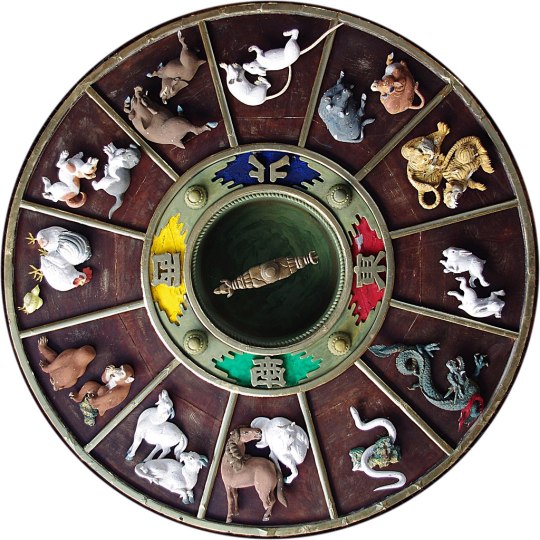
Finally, moving on to the Sheng Xiao, the Chinese Zodiac. There are 12 animals in total, which I already mentioned above. Getting to this point, I would also like to mention that I even researched what animals represent the Yin Yang and Wu Xing, just to check the consistency of Thomas. At the end, I wanted to say that I totally understand why he put the animals we currently have in the box.
The animals that represent the Yin and Yang are, respectively, Tiger and Dragon. Two animals that we already got in the zodiac. Gets worse with Wu Xing: Wood and Earth are represented by two more dragons, a Azure one (Qing Long) and a Golden one (Huang Long), while Fire, Metal and Water are the Vermilion Bird (Zhu Que), White Tiger (Bai Hu) and Black Tortoise (Xuan Wu), the last two being just varieties of animals that we already got in the box.
Back to the original matter again, shall we? All the signs within the zodiac are only equivalent and defined by a single element out of all the five and just one side of the Yin Yang, and that's what I'm going to use as a base to change the powers or just improve them. The list goes:
Mouse
• Water/Heart (Yang): Multitude
Ox
• Earth/Body (Yin): Resistance
Tiger
• Wood/Mind (Yang): Clout
Rabbit
• Wood/Mind (Yin): Burrow
Dragon
• Earth/Body (Yang): Elemental Storm Dragons or Wind, Lightning and Water Dragon
Snake
• Fire/Energy (Yin): Second Chance, honestly this is one that I might even have to change the name, maybe to something like Hypnosis – quite cliché I know
Horse
• Fire/Energy (Yang): Voyage
Goat
• Earth/Body (Yin): Genesis
Monkey
• Metal/Soul (Yang): Uproar
Rooster
• Metal/Soul (Yin): Sublimation
Dog
• Earth/Body (Yang): Fetch
Pig
• Water/Heart (Yin): Gift
I must say that I honestly don't intend to completely adapt, specifically the Sheng Xiao's animals powers, to the Yin Yang and Wu Xing molds, as it would completely change the powers, their symbolism, and their matchings with each canon holder, something I don't want because it would cause a mess in my head and I particularly appreciate the original content and stuff on the show. But I promise that I'll try my hardest to make at least some of them still contain precision.
Just like the other part of the posts about the remakes (the one that talks about how I am going to redesign the heroes' outfits), that end up in this one, I'll leave it to reveal the Miraculouses powers' changes in each individual post that addresses a particular hero.
Since this was a loooong text, I hope you enjoyed reading this far. Thanks for the attention!!!
And once again, credits to @loosescrewslefty
#ml powers#mlb powers#miraculous powers#miraculous ladybug powers#ml rewrite#mlb rewrite#miraculous rewrite#miraculous ladybug rewrite#ml#mlb#miraculous#miraculous ladybug#miraculous ladybug and chat noir#ladybug#chat noir#marinette#adrien
82 notes
·
View notes
Text
The Immortal & The Oni 🐉

As I already dived in the waters of the Oni history, I believed that I would not talk about it in the near future, yet here we are. As the show Undead Murder Farce slowly becomes a new obsession, an while I’m gathering all the materials necessary for my future project this seemed as a great in between project. (Cause apparently, I like to put way too much stuff into my hands)
The show presents us with an Oni, that was part of the Meiji purged against all the Yokai, and that now works in a “theater” [That is more like a freak show, common in all parts of the world at the time]. We soon found out that Tsugaru Shinuchi is in reality a half-Oni. We could think that he came to be born as a son of the intercourse of an Oni and a human, but it was someone that was able to transform him into an Oni.

And this important information is given to us by the head of what remains of the Immortal Aya Rindo. And we also find out that Aya is an immortal, thanks to the shoot on the dark were Tsugaru asks if she is an immortal.

You can read my other blog post for a more in depth explanation about the Oni, and how that change throughout the centuries, since I’m going to keep it short here.
Oni are part of the Yokai culture that always played an important part in Japanese lives. They are believed to be born from the fear of natural disasters and would then evolve into being associated with almost everything that a human could have considered as bad. Aya also says that the world Oni also means “servant of evil” (Cue the Vocaloid Song). That is an omen to one of the biggest legends about Onis, and that they were born after Izanagi’s being offended after her male counterpart saw her rooting in hell. In the Edo period we start to see a more comical version of this monsters that for so long hunted the Japanese minds. In the Shuten Doji we can see an Oni that regrets its killings, becomes obsessed with sake, and loses itself in woman. (Hello there Tsugaru ancestor) In these stories we also find Onis that are humans that slowly transform into Oni’s after slowing falling into the temptation of their stronger feelings and committing crimes.
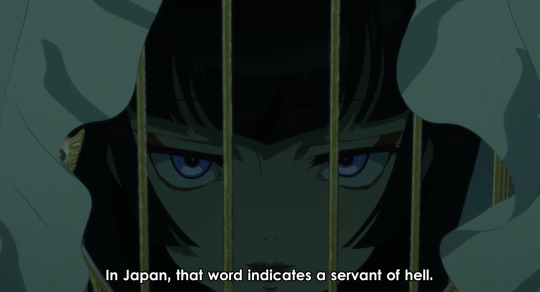
Now, Onis or Oni inspired characters are a common appearance in many media, but I think the idea of Immortal was a little different. Maybe if you also read Chinese novels like Danmei you can be somewhat familiarized with similar concepts, but the whole idea can still be a little confusing. So, what exactly is an Immortal?
The concept of the Immortal comes from Daoism where these beings have obtained an extended longevity after training for the control of their spirit and body. They are believed to be able to live from pure qi or dao – the foundations of the world. Living detached from the society, they obtained magical powers as an extension of the practice of transforming their qi into primordial qi. “Immortality implies the overcoming of the natural tendencies of the body and its transformation into a different kind of energetic constellation” (Kohn. 2009)
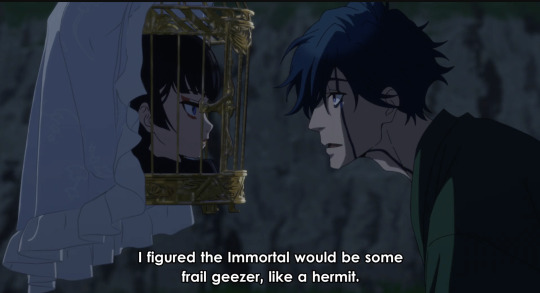
There are two types of immortals: the ones that were born from Dao, representing the core of heavens and scriptures, or the ones that were humans and transformed into immortals either thanks to elixirs or various practices that accessed the Dao. (Kohn, 2009) “Immortals are physical beings (…) But while the gods of the mainstream pantheon consists of high yang energy and the dead of high yin, immortals are beyond either, having bodies of ultimate yang that makes up the base of all others forms of qi” (Kohn, 2009)
It is funny to think about the reasoning behind why an Oni is the only creature that can kill an Immortal. The theory is mostly based on the five elements where there is not an element that is stronger than the other since there is always an element that can subdue the other. The same happen here, since Oni are the ones connected with hell (ying), they are the only ones able to kill an immortal that is mostly yang energy.

“Oni are the Yokai with the most negative associations” (Reiner, 2010) while an immortal is mostly associated with good things. They are in opposing sides of the spectrum and so they complement each other.
Bibliography:
KOHN, Livia. 2009 - Introducing Daoism. JBE Online books [Ebook];
REIDER, Noriko T. 2010 - Japanese Lore: Oni from Ancient time to present. Utah: Utah State University Press. [Ebook];
REIDER, Noriko T. 2003 - Transformation of the Oni: From the frightening and simbolical to the cute and sexy. Asian Folklore Studies, Volume 62, 133-157. Ohio: Miami University.
#undead girl murder farce#undead muder farce#oni#immortal#tsugaru shinuchi#aya rindo#history#japanese history#history research
7 notes
·
View notes
Note
now give us the kung fu panda rant
You guys really like enabling me huh
ANYWAY
There is so fucking much i can say about the brilliance of the kung fu panda series [the first two movies anyway. The third movie sucked and i stand by that] like...
Theres SO MANY buddhist philosophical principles scattered throughout the films, as well as HUGE attention paid to chinese culture [lord shen, for example, is a white peacock. In east asian cultures white is the colour of death, and ofc hes definitely not got clean hands. Wings. Whatever]. Someone pointed out that when po's learning to master inner peace in kfp 2 hes always doing so in dark, watery and naturally lit environments is brilliant bc those elements are associated with Yin in the concept of yin-yang
The fucking. THE FUCKING. EACH CHARACTER IS ASSIGNED A FORM OF KUNG FU BASED OFF THEIR SPECIES [tai lung uses leopard style, for example, and po himself uses bear style]. Also its a fucking TREAT to watch the fight scenes bc the choreography is fucking GLORIOUS and the exaggeration used does so well at heightening the action and making the fight scenes SO engaging without going overboard
The manner in which the characters are anthropomorphized is BRILLIANT too, particularly w characters like tigress and viper, or shen. Its just,,,,, augh its GOOD bc theyre Human Ish tm but you never forget that theyre animals. AND THATS WITHOUT MENTIONING THE SHEER DETAIL AND PERSONALITY THAT EACH DESIGN HAS
The growth of the characters never feels forced, either, and it's a fucking treat to watch dynamics change and shift and grow over the span of the first two films. Po learning to take pride in himself??? That fucking scene in the second movie where while hes moving that water droplet around the score is SWEEPING and we see flashes of his memories?? DELICIOUS. Dont even get me started on shifu's growth as a character i love how he learns to loosen up and enjoy kung fu again bc of po, and that he accepts and learns that his pain was the thing that held him back in the second??? Mwah. MWAH. Po's relationship w the five is so sweet btw i like how quickly they grow to like him bc of his Po-ness. Also i like whatever po and tigress have going on.
THE ART. THE ART????? THE COLOUR THEORY AND SYMBOLISM AND THE ENVIRONMENT DESIGNS AND THE WAY THAT THE WORLD FEELS SO LUSH AND LIVED IN??? OUGHGHGHGG. THE MUSIC??? THE FUCKING MUSIC?? NO WORDS. NO FUCKING WORDS MAN THE SCORE MAKES ME WANT TO BACKFLIP.
Also again on lord shen and tai lung,,,, theyre so good as villains bc even they have moments where you feel genuine sympathy for them,,,,, theyre so similar and yet so different and the writers did a brilliant job at making them genuinely horrifying as villains too. Like shen is GENUINELY scary and hes a fucking peacock.
Its just. Theyre GOOD MOVIES OK i love these stupid movies so much. I love the meaning behind them i love the effort put into symbolism and understanding chinese culture i love the music and the art i love that the second movie isnt afraid to be dark and by god i love that the funky panda and tiger are homies.
35 notes
·
View notes
Text
In today's (seventh) issue of symbolism, we will talk about the Yin-Yang symbol, which is found in the album and the performance of Karma.
"Yin-yang" is a symbol of Chinese origin. The Chinese call it Tai Chi — the circle of existence. It is symbolized by a circle divided into two equal parts of an S-shaped curve: dark, female (yin), and light, male (yang).
Yin is the feminine principle of matter, moist, dark, passive, soft, compliant and intuitive, associated with the earth, valley, trees and flowers, lunar animals and birds. In binary (polar) classification, it also symbolizes the north, darkness, death, earth, moon, even numbers, etc.
Yang is a masculine principle, dry, bright, active, firm, unbending, rational, associated with the sky, mountains, sunny animals and birds. In binary classification it is equated to the south, light, life, sky, sun, odd numbers.
This circle should be considered as rotating, as a result of which darkness inevitably gives way to light, and then light is replaced by darkness. Chinese philosophers claim that even in the purest light there is a certain element of darkness, and vice versa. Therefore, in the center of each half there is a small circle painted in the opposite color: black on a white background and white on black.
At the heart of this symbolism, as is commonly believed, are the teachings of the ancients about fertility, reproduction, phallic cult, etc. This interpretation is considered, for example, in ancient China not as a result of confrontation, but as a result of the interaction of opposites, that is, their unity.
This simple image of balanced dynamism symbolizes the interdependence of opposing forces and principles in the cosmos. Creative tension, alternation and fusion of yin-yang generate change and movement, development and complication.
In Taoism, these are the basic concepts of ancient Chinese natural philosophy, universal cosmic polar and constantly shifting forces into each other.
Yin (dark/feminine) and yang (light/masculine) are understood as polar modalities of a single substantial principle — pneuma (qi) and represent two types of universal forces embodied in five elements, which, in turn, constitute the essence of the manifested world: wood, fire — yang; earth — neutral; metal, water is yin. Just as the Tao establishes balance, yin and yang need it. Yin and yang are inseparable and complement each other. Life cannot be colored only in dark colors and vice versa; to think otherwise is to show recklessness. If you follow the Tao (path), then these two forces, which at the same time are both opposite and complementary, will remain in harmony.
This idea represents the basic concept of Taoism: a balanced approach to all natural phenomena and correction in case of a violation of the natural balance.
Graphically, the concept of Taoism is expressed by Tai chi (in some sources — Tai Shi) — a symbol of the single limit. Black color symbolizes yin, white — yang. The two opposites form a single whole, complementing each other and flowing into each other. The symbol demonstrates the primordial dualism of all things. At the same time, all things are characterized by the presence of both masculine and feminine, the manifestation of both dark and light aspects, and the feminine necessarily contains an element of masculine, and vice versa.
This symbol represents a continuous movement, an ongoing process, leaving no room for static equilibrium, asserting the dynamism of the balance of forces.
The yin-yang symbolism permeates all spheres of the Chinese national way of life and culture. And yet, this culture cannot be considered the property of one people, since many religions have adopted similar theories.
The philosophy of yin-yang cannot be considered a kind of verdict of fate, but only a statement of the existing order of things. The basis of any life manifestation is the balance of two opposites: growth and extinction, happiness and sadness, gain and loss… A wise person sees the duality of all things and lives in harmony with this reality. It is this approach that allows you to live happily and regardless of the black or white stripes in a person's fate.
In neo-Confucianism, yin—yang is a manifestation of rest or movement of a single substance — the Great Limit (Tai chi).

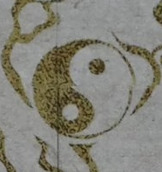
3 notes
·
View notes
Text
Herbal Chinese Medicine Near Arizona
Herbal Chinese Medicine Near Arizona
Chinese medicine herbs are essential for good health, Chinese natural herbs are commonly used today for their effectiveness for a number of common illnesses – this method goes back at least 2,000 years.
Over that time, a vast amount of experience has been gained that has gone towards perfecting clinical applications. Our herbs can greatly increase the effectiveness of modern drug treatments, reduce their side-effects,
Our herbs consist of thousands of plant species. Herbal Chinese Medicine Near Arizona are most often taken in combinations of herbs rather than on their own. By combining herbs, synergies have been discovered that vastly increase the medicinal effects. Our formulas consist of principal herbs, assisting herbs, directional herbs, and herbs that reduce the side effects, or aid the digestion of a particular herb.
At Eastern Medicine Center, we have the most comprehensive supply of 350+ dried raw herbs from China, America and other countries in the valley.
Visit Our clinic and herbal medicine store online and in. person located in Scottsdale, Arizona.
Herbal Chinese Medicine Near Arizona, a cornerstone of Traditional Chinese Medicine (TCM), has been practiced for thousands of years, leveraging the therapeutic properties of plants and natural substances to promote health and treat illness. This ancient practice is deeply rooted in the philosophy of harmony and balance within the body and between the body and its environment.
Historical Context
The origins of herbal Chinese medicine date back to ancient China, with the earliest records found in texts such as the "Shennong Ben Cao Jing" (Shennong's Classic of Materia Medica), which dates back to around 200 CE. This text lists hundreds of herbs and their medicinal properties, forming the foundation for later developments in TCM. Over the centuries, herbal medicine evolved through empirical practice and scholarly refinement, integrating new herbs and formulations as they were discovered and tested.
Principles and Theory
At the heart Herbal Chinese Medicine Near Arizona is the concept of Qi (vital energy), Yin and Yang (the dual forces that must be balanced for health), and the Five Elements (Wood, Fire, Earth, Metal, and Water) that represent different aspects of physiological functions and their interactions. Disease is seen as a result of imbalances or disruptions in these elements and forces.
Herbs are classified according to their energetic properties, such as temperature (hot, warm, cool, cold), flavor (pungent, sweet, sour, bitter, salty), and their specific effects on various organs and meridians (energy pathways). For example, ginseng (Ren Shen) is considered warm and sweet, beneficial for tonifying Qi and strengthening the spleen and lungs. Conversely, mint (Bo He) is cool and pungent, used to expel wind-heat and soothe the liver.
Common Herbs and Formulations
TCM practitioners typically use herbal formulations rather than single herbs to create a synergistic effect, enhancing therapeutic efficacy while minimizing side effects. One famous example is "Liu Wei Di Huang Wan" (Six Flavor Rehmannia Pill), a classic formula used to nourish Yin and treat deficiencies in the liver and kidneys. This formula combines six herbs, including Rehmannia root, Cornus fruit, and Dioscorea, each contributing to the overall balance and effect.
Modern Applications and Research
In contemporary times, herbal Chinese medicine has gained global recognition, with growing interest in its integrative approach to health. Modern research has focused on understanding the pharmacological properties of these herbs, aiming to validate their traditional uses and explore potential new applications. For instance, studies have demonstrated the immunomodulatory effects of astragalus (Huang Qi) and the anti-inflammatory properties of turmeric (Jiang Huang).
Challenges and Considerations
Despite its benefits, herbal Chinese medicine faces challenges such as quality control, standardization, and safety concerns, particularly regarding herb-drug interactions and contamination with heavy metals or pesticides. It is crucial for practitioners to source high-quality herbs and for patients to consult qualified TCM practitioners to ensure safe and effective treatment.
Conclusion
Herbal Chinese Medicine Near Arizona represents a rich tradition of natural healing, blending ancient wisdom with modern scientific inquiry. By focusing on the body's intrinsic balance and using the natural properties of herbs, it offers a holistic approach to health and well-being that continues to be relevant in today's world. As research progresses, the integration of herbal Chinese medicine into mainstream healthcare holds promise for enhancing our understanding and management of health and disease.
0 notes
Text
Black-yellow Picture(玄黄図)

A picture I did about 15 years ago.
on the yellow earth
from the black sky
Seven crows flew down,
playing or eating.
This color usage is based on the Chinese theory of Yin-Yang and Five Elements.
Van Gogh drew "Crows Flying Over Wheat Fields"
And the colors are roughly the same.
18.08.2022
#picture#the yellow earth#the black sky#Seven crows#theory of Yin-Yang and Five Elements#Van Gogh#Black-yellow Picture#玄黄図#rei morishita
8 notes
·
View notes
Text
How Chinese Medicine Tailors Treatments to Individual Needs
Chinese Medicine, a holistic approach to health and wellness, tailors treatments to individual needs through several key principles:
Diagnosis Based on Patterns: Chinese Medicine practitioners diagnose patients based on patterns of symptoms rather than specific diseases. They observe factors such as tongue appearance, pulse qualities, and overall constitution to understand the underlying imbalance in the body.
Yin-Yang Balance: This concept is fundamental in Chinese Medicine. Health is believed to depend on the balance of yin (cold, dark, passive) and yang (hot, bright, active) energies in the body. Treatments aim to restore this balance, which can vary greatly between individuals.
Five Element Theory: Another foundational concept is the Five Element Theory, which categorizes the body's functions and organs into five elements: Wood, Fire, Earth, Metal, and Water. Each element is associated with specific organs and functions, and imbalances are addressed through treatments tailored to the individual's elemental constitution.
Herbal Medicine: Chinese herbal medicine utilizes a vast array of herbs, minerals, and animal products, often combined into formulas tailored to the patient's specific needs. These formulas are adjusted based on the individual's symptoms, constitution, and response to treatment.
Acupuncture and Moxibustion: These techniques involve the insertion of fine needles or the application of heat to specific points on the body to regulate the flow of qi (vital energy). The selection of acupuncture points is based on the patient's unique pattern of disharmony.
Dietary Therapy: Chinese Medicine emphasizes the importance of diet in maintaining health and treating illness. Recommendations are personalized based on the individual's constitution and pattern of disharmony, with certain foods prescribed to nourish specific organs or balance yin and yang energies.
Lifestyle Recommendations: Practitioners may also provide guidance on lifestyle factors such as exercise, stress management, and sleep hygiene, tailored to the individual's needs and imbalances.
Overall, Chinese herbal medicine recognizes that each person is unique, and treatments are customized to address their specific patterns of disharmony, constitutional factors, and overall health goals. This personalized approach aims to restore balance and promote wellness in body, mind, and spirit.
0 notes
Text
Traditional Chinese Medicine Courses by Eran Even

Eran Even invites you to embark on an enriching journey into the profound realm of Traditional Chinese Medicine (TCM). With a deep reverence for the ancient wisdom that has sustained countless generations, Eran Even offers a range of comprehensive courses designed to illuminate the principles and practices of TCM.
Course Offerings:
Foundations of TCM: Explore the fundamental principles of TCM, including Yin and Yang theory, Five Element theory, and the meridian system. Gain insight into the holistic approach to health and wellness that has been the cornerstone of TCM for centuries.
Acupuncture Essentials: Delve into the art and science of acupuncture, learning about point location, needling techniques, and safety protocols. Develop the skills necessary to perform effective acupuncture treatments and promote balance and harmony within the body.
Herbal Medicine Mastery: Discover the power of herbal medicine in restoring health and vitality. Learn about the properties, actions, and clinical applications of commonly used herbs, and explore the art of herbal formulation and prescription.
Tui Na Massage Techniques: Experience the healing touch of Tui Na massage, a traditional Chinese therapeutic modality. Master various massage techniques, including pushing, grasping, kneading, and tapping, and learn how to address common health complaints through targeted bodywork.
Dietary Therapy and Nutrition: Uncover the secrets of TCM dietary therapy and nutrition, and learn how to use food as medicine to support overall well-being. Explore the energetics of food, constitutional typing, and therapeutic meal planning for optimal health.
Qigong and Mind-Body Practices: Immerse yourself in the ancient practice of Qigong, combining gentle movements, breathing exercises, and meditation to cultivate Qi and promote inner harmony. Learn how to harness the power of Qigong for self-healing, stress reduction, and emotional balance.
Why Choose Eran Even's Courses?
Eran Even's TCM courses offer a unique blend of scholarly knowledge, practical skills, and experiential learning. With Eran's guidance, students can expect to deepen their understanding of TCM principles and techniques while gaining hands-on experience in a supportive and nurturing environment. Whether you're a healthcare professional looking to integrate TCM into your practice or an individual seeking to enhance your own health and well-being, Eran Even's courses provide a transformative learning experience rooted in centuries of tradition and wisdom.
Join Us Today!
Embark on a journey of discovery and transformation with Traditional Chinese Medicine courses by Eran Even. Whether you're taking your first steps into the world of TCM or seeking to deepen your knowledge and skills, Eran Even's courses offer a pathway to greater understanding, healing, and vitality. Enroll now and unlock the ancient wisdom of Traditional Chinese Medicine.
#tcm medicine coquitlam#tcm doctor coquitlam#local acupuncturists coquitlam#tcm doctor vancouver#traditional chinese medicine courses#chinese medicine practitioners#dr tcm port moody
1 note
·
View note
Text
Unlocking the Healing Powers of Traditional Chinese Medicine: A Comprehensive Guide
Introduction: Traditional Chinese Medicine (TCM) has been practiced for centuries, offering a holistic approach to healthcare that focuses on restoring balance and harmony within the body. In this SEO blog, we delve into the fascinating world of TCM, exploring its principles, therapies, and the potential benefits it holds for those seeking natural and alternative healing methods. Join us as we unravel the mysteries of this ancient medicinal system and discover how it can enhance your well-being.
Section 1: Understanding Traditional Chinese Medicine
An Overview of Traditional Chinese Medicine: Its Origins and Philosophy
The Concept of Qi: Vital Energy in TCM
Yin and Yang: Balancing Opposing Forces in the Body
The Five Elements Theory: Exploring the Interconnectedness of the Body and Nature
Section 2: Key Therapies in Traditional Chinese Medicine
Acupuncture: Restoring the Flow of Energy
Herbal Medicine: Harnessing the Power of Nature
Cupping Therapy: Promoting Circulation and Detoxification
Tui Na Massage: Balancing Energy and Alleviating Pain
Qi Gong and Tai Chi: Cultivating Mind-Body Harmony
Section 3: Conditions Treated by Traditional Chinese Medicine
Stress and Anxiety: Calming the Mind and Soothing the Spirit
Chronic Pain Management: Natural Alternatives to Conventional Treatments
Digestive Disorders: Restoring Balance in the Gut
Insomnia and Sleep Disorders: Promoting Quality Sleep
Women’s Health: Balancing Hormones and Enhancing Fertility
Section 4: Incorporating Traditional Chinese Medicine into Your Lifestyle
Finding a Qualified TCM Practitioner: Choosing the Right Healthcare Provider
Integrating TCM with Western Medicine: Complementary Approaches
TCM Dietary Principles: Nourishing Your Body from Within
Lifestyle Recommendations: Exercise, Stress Management, and Self-Care
Conclusion: Traditional Chinese Medicine offers a rich tapestry of therapeutic modalities that have stood the test of time. By embracing TCM principles and therapies, individuals can tap into a comprehensive system that nurtures the body, mind, and spirit. Whether seeking relief from a specific health condition or simply striving for overall well-being, TCM can transform your approach to health and empower you on your journey toward vitality and balance.
Remember, before embarking on any new healthcare regimen, it is essential to consult with a qualified healthcare professional to ensure personalized guidance and appropriate treatment. Embrace the wisdom of Traditional Chinese Medicine and unlock the secrets of ancient healing for a brighter, healthier future.
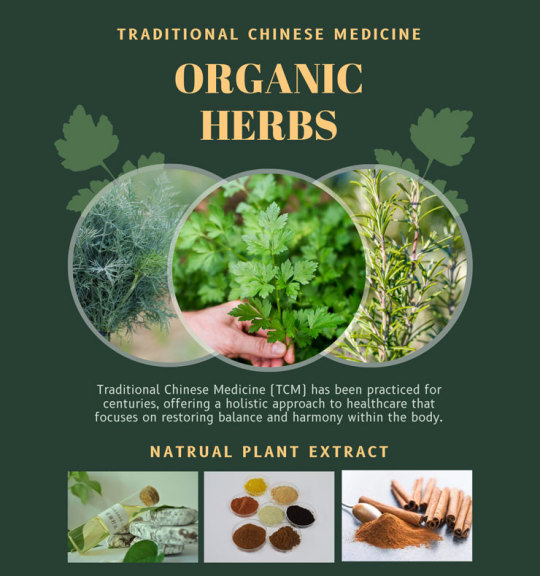
traditional Chinese medicine
0 notes
Text
IRWOROBONGDO
STRAY KIDS THEORY
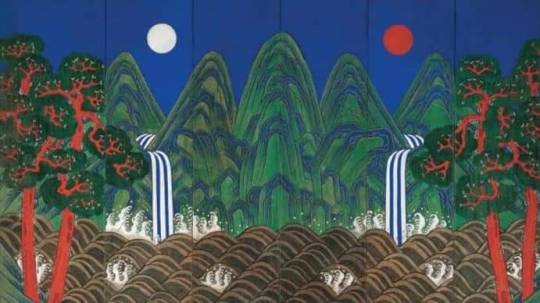
Irworobongdo (Korean: 일월오봉도, Hanja: 日月五峯圖) is a Korean folding screen with a highly stylized landscape painting of a sun and moon, five peaks which always was set behind Eojwa, the king’s royal throne during the Joseon Dynasty. It literally means “Painting of the Sun, Moon and the Five Peaks” and is also called “Irwoldo” (“Painting of the Sun and Moon”) or “Irwolgonryundo” (“Painting of the Sun, Moon and Mount Kunlun”).
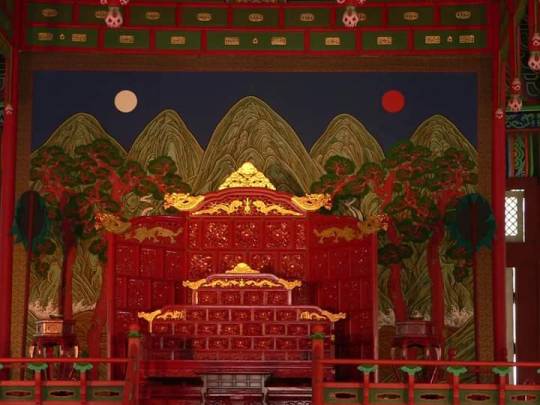
The sun and moon symbolize the king and queen while the five peaks denotes a mythical place. The screen serves to display the majesty of the Joseon royal court.

There are no existing documents from an early period to explain the original iconography of the Five Peaks. Chadwick reports the findings of Dr. Yi Song-mi, Professor of Art History at the Academy of Korean Studies in Seoul.

He has suggested that these screens were one of the most important elements in the throne hall, and that this formalized landscape illustrates the Joseon political cosmology.
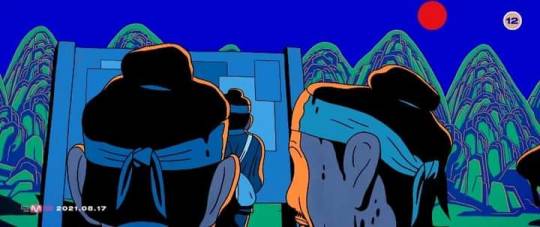
The "almost" red sun represents the king as the yang, the positive male principle, while the white moon represents the queen as the yin, the negative female principle. These two principles make the universe work.

An alternative explanation is that the screen might represent the blessing of Korea by Heaven, symbolized by the sun and moon in balance. When the king sat in front of this screen, he appeared to be at the pivotal point from which all force emanated and to which all returned. Thus, imbued with sacred power, the screen manifests a political cosmology as evidence of Heaven's favour, mandate, and continued protection of the ruler.
Wikipedia
1 note
·
View note